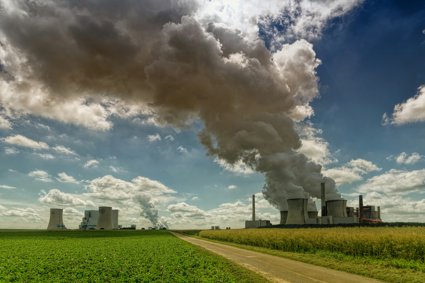
What causes climate change?
This module will help students to understand:
-
What can cause climate change?
-
How do human actions affect climate change?
-
What are emissions, and how do they influence climate change?
Does the sun cause climate change?
It is true that changes in solar activity does affect global temperatures. Changes in the energy output of the Sun, and the Earth’s orbit around the Sun, do have an effect on the Earth’s climate.
Ice ages have come and gone in regular cycles for nearly three million years. There is strong evidence that these are linked to regular variations in the Earth’s orbit around the Sun, the so-called Milankovitch cycles. These cycles change the amount of the Sun’s energy received by different places on the Earth’s surface.
However, over the last 50 years, increased greenhouse gas concentrations have had a much greater effect than changes in the Sun's energy.
Variation in the energy output of the Sun over the past 150 years
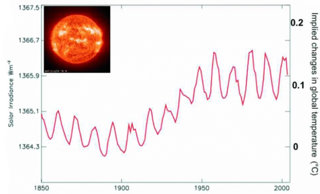
Met Office Hadley Centre for Climate Prediction and Research, 2005, Climate Change and the greenhouse effect, p10
-
This graphic shows the Sun's energy output over typical 11 year cycles
-
The horizontal, x, axis, shows the time in years from 1850 to 2000
-
The vertical, y, axis , shows the amount of energy the earth gets from the Sun
-
The Sun's energy output varies with the number of sun spots, on an 11 year cycle
-
The Sun became slightly more active between 1900 and 1950. This accounts for an estimated 0.1ºC of the global temperature rise during that time
How has the greenhouse effect changed?
Naturally occurring gases in our atmosphere, such as carbon dioxide and methane, provide an insulating effect without which the earth would be a frozen planet. However, levels of greenhouses gases in the atmosphere have increased, preventing more heat escaping to Space and leading to ‘global warming’.
Any increases in the levels of greenhouse gases in the atmosphere mean that less heat escapes to Space and global temperatures increase - an effect known as 'global warming'.
Over the past 150 years in the industrial era, human activities have increased the emissions of three principal green house gases: carbon dioxide, methane and nitrous oxide. These gases accumulate in the atmosphere, causing concentrations to increase with time.
Carbon dioxide (CO₂) has increased from our use of fossil fuels which we burn for use in transportation, energy generation, building heating and cooling. Deforestation also releases CO2 and re duces its uptake by plants.
Methane (CH₄) has more than doubled as a result of human activities related to agriculture, natural gas distribution and landfills. However, increases in methane concentrations are slowing down because the growth of emissions has decreased over the last two decades.
Nitrous oxide (N₂0) is also emitted by human activities such as fertilizer use and fossil fuel burning.
There are other, lesser, contributors such as CFCs (whose emissions have decreased substantially) and ozone in the lower atmosphere.
Water vapour is the most abundant and important greenhouse gas in the atmosphere. However, human activities have only a small direct influence on the amount of atmospheric water vapour. Indirectly, humans have the potential to affect water vapour substantially by changing climate as a warmer atmosphere contains more water vapour.
Aerosols are small particles present in the atmosphere with widely varying size, concentration and chemical composition. Fossil fuel and biomass burning have increased aerosols containing sulphur compounds, organic compounds and black carbon (soot).
Levels of carbon dioxide, methane and nitrous oxide in the atmosphere over the past 2000 years
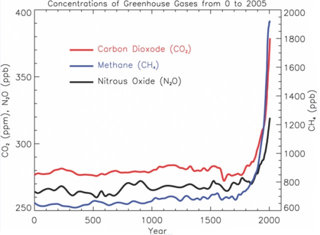
 Intergovernmental Panel on Climate Change (2007) IPCC Fourth Assessment Report. Climate Change. [Accessed June 2009]
Intergovernmental Panel on Climate Change (2007) IPCC Fourth Assessment Report. Climate Change. [Accessed June 2009]
-
This graphic shows levels of carbon dioxide, methane and nitrous oxide in the atmosphere over the past 2000 years
-
The horizontal, x, axis shows time in years from 0 to 2000 AD
-
The vertical, y, axis shows the concentration of each gas in the atmosphere
-
Each coloured line shows the amount of one greenhouse gas in the atmosphere
What has caused the rise in temperatures over the past 100 years?
In the first half of the 20th century global temperatures have risen because of increases in the levels of greenhouse gases in the atmosphere as well as changes in the amount of energy emitted by the Sun. In the second half of the 20th century warming is mainly due to changing greenhouse gas concentrations.
Sulphate particles from industrial emissions reflect solar radiation and therefore act to cool climate. These particles helped mask the warming for a few decades from 1940, but then reductions in these pollutants together with ever increasing concentrations of greenhouse gases led to renewed warming from the 1970s.
Both graphs: Observed and simulated global average temperatures
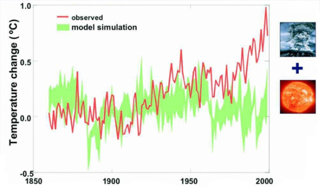
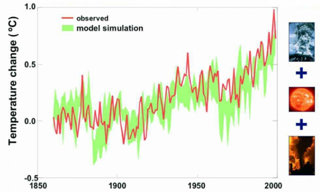
Met Office Hadley Centre for Climate Prediction and Research, 2005, Climate Change and the greenhouse effect, p28/29
-
These graphics show observed and simulated global average temperatures
-
The horizontal, x, axis shows time in years from 1850 to 2005
-
The vertical, y, axis shows how different the temperature is from the 1961-1990 average
-
The red line shows the temperature of the Earth's surface, as measured by instruments and satellites
-
(Graph 1) When only told about changes in volcanic and solar emissions, climate models (green shaded area) do not recreate observed temperatures well
-
(Graph 2) When told about natural and human-made changes to the atmosphere, climate models (green shaded area) recreate observed temperatures very well
What is the greenhouse effect?
It is essential to human life! The natural greenhouse gas effect keeps Earth much warmer than it would otherwise be. Without the greenhouse effect, planet Earth would be too cold to support human life as we know it.
The temperature of the Earth is determined by the balance between energy coming in from the Sun in the form of visible radiation (sunlight) and energy constantly being emitted from the surface of the Earth to outer space in the form of invisible infrared radiation (heat).
The energy coming in from the Sun can pass through the clear atmosphere pretty much unchanged and therefore heat the surface of the Earth. But the infrared radiation emanating from the surface of the Earth is partly absorbed by some gases in the atmosphere, and some of it is re-emitted downwards. The effect of this is to warm the surface of the Earth and lower part of the atmosphere. This is called the greenhouse effect.
The absorbing gases in the atmosphere are primarily water vapour (responsible for about two-thirds of the effect) and carbon dioxide. Methane, nitrous oxide, ozone and several other gases present in the atmo sphere in small amounts also contribute to the greenhouse effect. Without the greenhouse effect the Earth would be, on average, about 33°C colder than it presently is.
The greenhouse effect
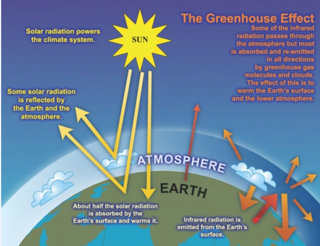
Intergovernmental Panel on Climate Change (2007) IPCC Fourth Assessment Report. Climate Change. [Accessed June 2009]
What other things can change the climate?
Well volcanic eruptions certainly play their part! There were three volcanic eruptions big enough to affect the climate in the 20thcentury.
There were three volcanic eruptions big enough to affect the climate in the 20th century – Agung in Indonesia (1963), El Chichon in Mexico (1982) and Pinatubo in the Philippines (1991).
Material (particles) from violent volcanic eruptions can be projected far above the highest cloud, and into the stratosphere where they can significantly increase how much incoming solar energy is reflected. Major volcanic eruptions can reduce average global surface temperature by about 0.5°C for months or even years.
However, volcanic eruptions are not the only factor that can influence the climate. There are three ways to change the radiation balance of the Earth:
-
By changing the incoming energy from the Sun, for example by changes in Earth’s orbit or in the Sun itself
-
By changing the fraction of solar radiation that is reflected, for example by changes in cloud cover, vegetation or atmospheric particles such as volcanic material or sulphate aerosols
-
By changing greenhouse gas concentrations, for instance, the amount of carbon dioxide in the atmosphere has increased by about 35% in the industrial era, and this increase is known to be due to human activities, primarily the burning of fossil fuels and removal of forests
Measure of the amount of volcanic dust in the atmosphere
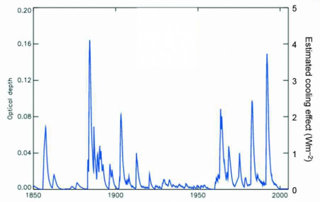
 Met Office Hadley Centre for Climate Prediction and Research, 2005, Climate Change and the greenhouse effect, p11
Met Office Hadley Centre for Climate Prediction and Research, 2005, Climate Change and the greenhouse effect, p11
-
This graphic shows the amount of volcanic dust in the atmosphere from 1850-2000
-
The horizontal, x, axis shows time in years from 1850-2000
-
The vertical, y, axis shows the amount of volcanic dust in the atmosphere
-
Only really big volcanic eruptions like Krakatoa (1883), Agung (1963), El Chichon (1982) and Pinatubo (1991), push dust high into the atmosphere
File nameFiles
File type
Size
Download

